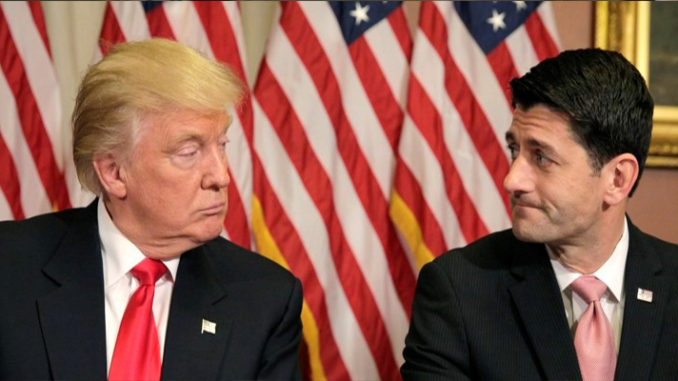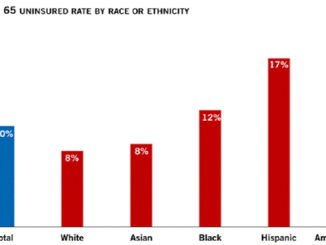
by James Capretta
The Trump administration and Republicans in Congress find themselves in a position there never wanted to be in: heading into the August recess having failed to repeal and replace the Affordable Care Act (ACA), and also without any significant legislative accomplishments since the November 2016 election.
Before charting a new course, the GOP needs to understand how they drove themselves into this political ditch.
The Initial Embrace of the Doomed “Repeal and Delay” Strategy.
In the weeks after the November 2016 election, elated Republicans planned a quick strike “repeal and delay” bill for the ACA. The idea was to follow the script the party used in 2015 to put a repeal-only bill on President Obama’s desk. With “repeal and delay,” the party could avoid the difficult internal discussions on how to reform health care and just focus on gutting the ACA, with delayed effective dates to allow time for the Congress to come up with a replacement plan later. This strategy was never going to work, but many conservatives argued that it should because of the successful test run of 2015 (a bill was sent to President Obama, who vetoed it). Conservatives made the case for months that a House or Senate member who voted for this approach in 2015 should do so again in 2017. But that is a disingenuous argument. It was obvious in 2015 that the repeal and delay bill was never going to become law, and so it was a way for the GOP to voice dissatisfaction with the ACA without having to replace its key provisions. It was clear then to anyone who paid attention that any repeal bill would have to include replacement provisions to have any chance of success because a repeal-only bill would instantly create a massive disruption in the marketplace for many millions of consumers. Still, some in the GOP who should know better convinced themselves that a repeal-only bill could work. The party wasted the first few precious months after the election on this doomed scheme.
Lack of a Clear Policy Direction from the Trump Administration Hampered the Effort.
President Trump ran successfully in 2016 without ever specifying a clear agenda, including on health care. That lack of clear direction probably helped Trump avoid needless controversy as a candidate but it has hurt the ability of the GOP to unite around a positive agenda. If Trump had been clearer about what he would do instead of the ACA, and won the election with that agenda clearly presented to the voters, it would have helped push the GOP toward a consensus. As matters stand, however, the administration has no clear positions on any of the major issues in question. Moreover, the president has made it clear in his remarks that he cares much more about something passing than what is in it. It is very difficult to pass legislation as complex and controversial as health reform without a strong push from the executive branch on key details of the overall framework.
An Entirely Partisan Approach on Health Care Was a Bad Idea.
There’s a reason that major social legislation usually passes with votes from both parties. It’s because laws that are entirely partisan engender political resentment, which leads to instability. The Obama administration pushed the ACA through Congress in 2010 with no Republicans voting in support of the final bill. Over the four ensuing election cycles, Democratic officeholders paid a heavy political price for the legislation. Moreover, the ACA is more unstable programmatically because of opposition to it from Republicans. Before the effort collapsed this week, the GOP was trying to replicate the Democrats’ strategy by relying on just Republican votes to pass legislation replacing key features of the ACA with new provisions. Even if they could pass legislation this way, they shouldn’t have tried because whatever they did would probably be reversed too when the Democrats were next in power. Of course, it is now clear that the difficulty of passing such controversial legislation is too heavy of a lift for a Republican majority with just two votes to spare in the Senate.
CBO’s Emphatic Support of the Individual Mandate Presents Challenges.
The GOP effort to move away from key ACA provisions was dealt a series of blows when the Congressional Budget Office (CBO) released its estimates of the various versions of the legislation. With each estimate, CBO made it clear that the GOP’s desire to eliminate the tax penalties associated with the individual mandate would dramatically increase the number of Americans going without health insurance. For the House-passed bill, CBO estimated there would be an additional 23 million people without health insurance in 2026 compared to current law. For the draft Senate legislation released in June, CBO estimated the increase would be 22 million. These estimates made a deep impression on public opinion and created significant political problems for House and Senate members. Republican opponents of the mandate have never come up with a credible alternative that would ensure the marketplace would function smoothly while still providing protections to people with pre-existing conditions.
At this point, the GOP does not have much choice but to step away from the effort to roll back the ACA and reconsider its options. Republicans have squandered the most important months of a new presidency, and they have also given up significant leverage in the process. Still, there is time to proceed with a different and more promising approach if there is a desire to do so.
To get a better result with a renewed push, the GOP should include willing Democratic senators in the conversation. The party should understand that the goal should be a plan that costs less, reduces regulations, and injects serious market discipline into the system, even while ensuring all Americans have ready access to insurance. That may mean finding a compromise approach on giving individuals strong incentives to enroll in health insurance. The party should also work with GOP governors to find a reasonable and affordable compromise on Medicaid, one that provides for significant reform of the program, with more state control and clear federal budgetary restraints, while also providing a safety net to all Americans with incomes below the poverty line.
It would have been easier, and more fruitful, to pursue a bipartisan deal of this kind in the weeks after the election. That was when Republicans had the most power. But they still have some leverage. They should use it when the time is right to begin the process of moving the health policy in a direction more to their liking. That will inevitably be less satisfying to some than writing a bill entirely on their own because of the compromises that will be necessary, but this kind of legislation would be far more likely to pass, and also survive when political control inevitably changes again.
James C. Capretta is a resident fellow and holds the Milton Friedman Chair at the American Enterprise Institute, where he studies health care, entitlement, and US budgetary policy, as well as global trends in aging, health, and retirement programs.



